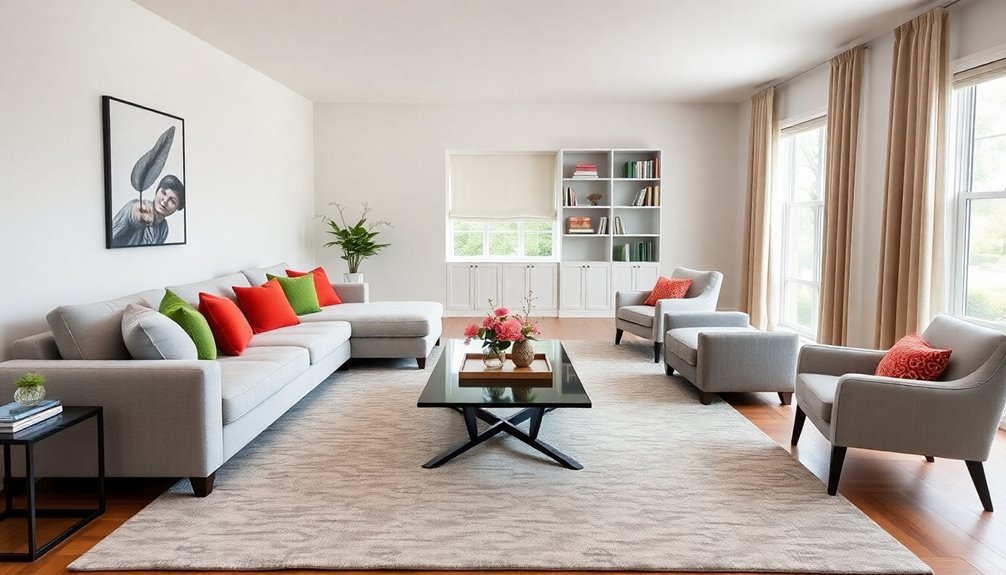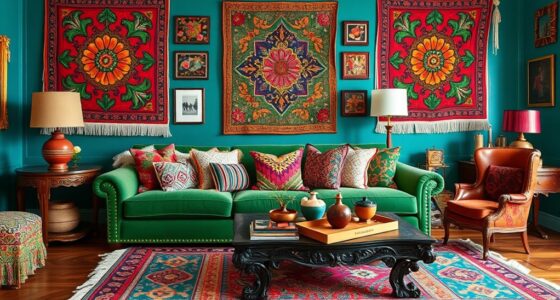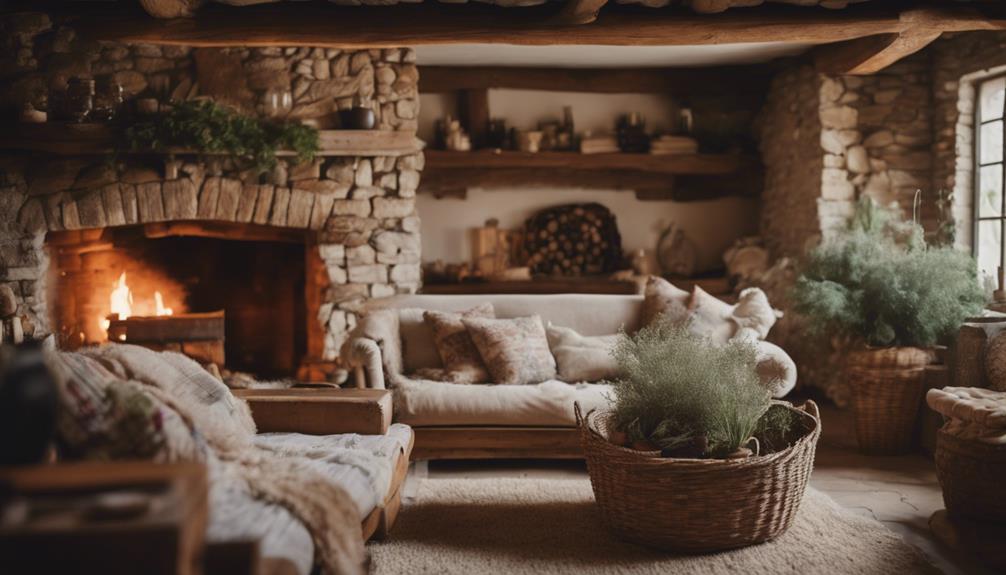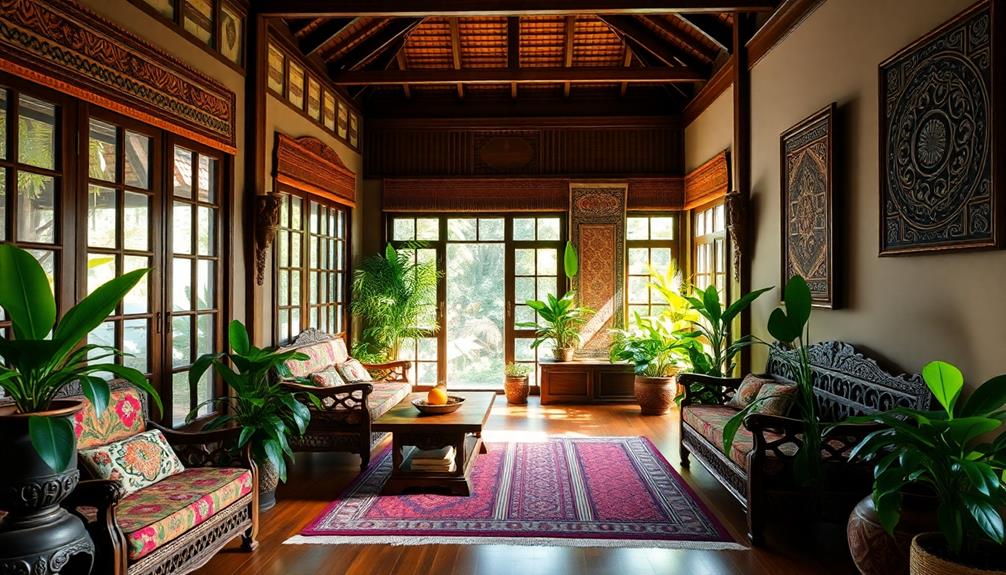To arrange furniture in a long living room, start by assessing the space and measuring your longest wall. Define separate zones, such as sitting and entertainment areas, using area rugs for visual boundaries. Position your main furniture along the longest wall to create an anchor point, and consider an L-shaped sofa to enhance the flow. Identify a focal point, like a fireplace, and arrange seating symmetrically around it. Use appropriately sized furniture, balancing larger and smaller pieces, and maintain clear pathways to avoid congestion. There’s much more to explore to perfect your layout. In addition to these foundational steps, consider the scale and proportion of your furniture relative to the room’s dimensions. When arranging furniture in rectangular rooms, it’s vital to ensure that each zone flows seamlessly into the next, while still catering to the functional needs of the space. Don’t shy away from experimenting with the layout until you find a configuration that promotes both comfort and aesthetic appeal.
Key Takeaways
- Position larger furniture pieces, such as sofas, along the longest wall to create a natural anchor for the room.
- Divide the space into distinct zones, like sitting and entertainment areas, using area rugs for visual separation.
- Maintain clear pathways by ensuring sufficient space between furniture for easy movement and accessibility.
- Utilize L-shaped sofas to enhance visual separation while fitting snugly into corners of the long room.
- Incorporate a focal point, such as a fireplace or artwork, and arrange furniture symmetrically around it for balance.
Assessing the Space
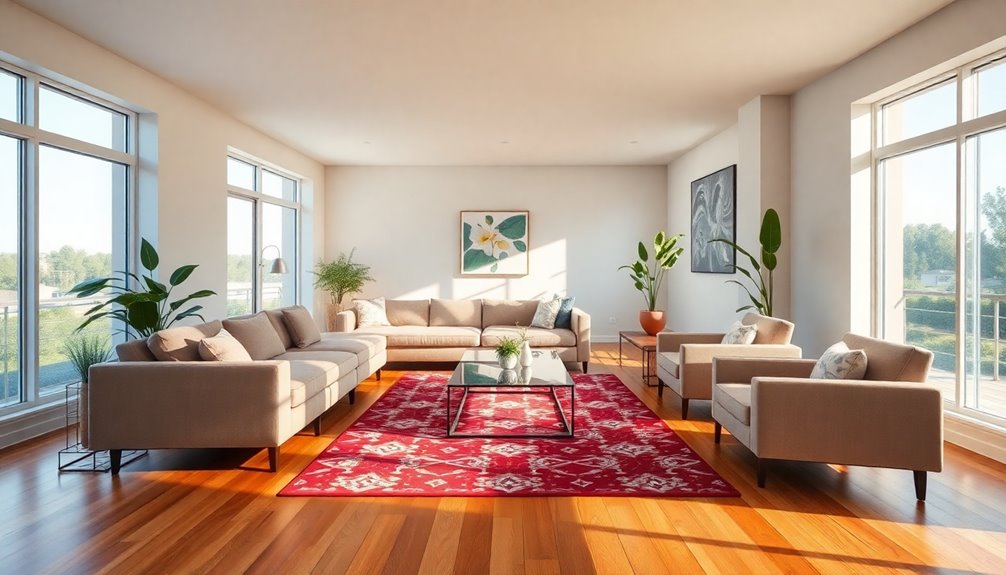
When arranging furniture in a long living room, the first step is assessing the space to create a functional and inviting layout. Start by measuring the longest wall and the width of the shorter wall. Take note of any architectural features, like doorways, windows, or built-in bookshelves that could influence your design. Don't forget to measure the ceiling height and identify any obstructions like soffits.
Sketch out your floor plan on paper or use an online tool like Floorplanner to visualize the space. Record the exact dimensions, such as 22'10" x 11'11", to help you make informed decisions.
Next, identify key features in the room. Look for the size and location of doors and windows, and consider fixed elements like a fireplace. This will help you determine the best furniture placement and ensure essential features remain accessible. Additionally, consider traffic flow analysis to help identify natural movement paths that enhance overall functionality.
Lastly, assess traffic flow by ensuring clear paths through the room. Leave enough space between furniture for easy movement and avoid blocking doorways or windows. This thoughtful assessment lays the groundwork for an inviting and functional living room layout.
Defining Zones and Layouts

After you've assessed the space in your long living room, the next step is defining zones and layouts to maximize functionality and flow. Start by dividing the room into distinct areas, like a sitting area, entertainment zone, or workspace. Use area rugs to visually anchor each zone, providing clear boundaries and a more organized appearance. Tall bookcases or furniture at the ends of the room can counter the 'bowling alley' effect while emphasizing vertical lines. Incorporating sustainable materials in your furniture choices can also enhance the overall aesthetic while being eco-friendly.
When laying out your furniture, place your main pieces, like a sofa or sectional, along the largest uninterrupted wall to anchor the entertaining area. If your room has an open floor plan, consider an L-shaped sofa to create visual separation between zones. Positioning furniture in the center can also foster a spacious feel, as floating furniture away from walls promotes a sense of flow and intimacy.
Ensure there's a clear traffic flow, with a couple of feet between furniture pieces for ease of movement. Avoid clustering all your furniture in one area to prevent a cramped atmosphere. Lastly, balance the room by mixing small and large items, as well as using vertical stripes or large mirrors to enhance visual interest and create the illusion of more space.
Identifying a Focal Point
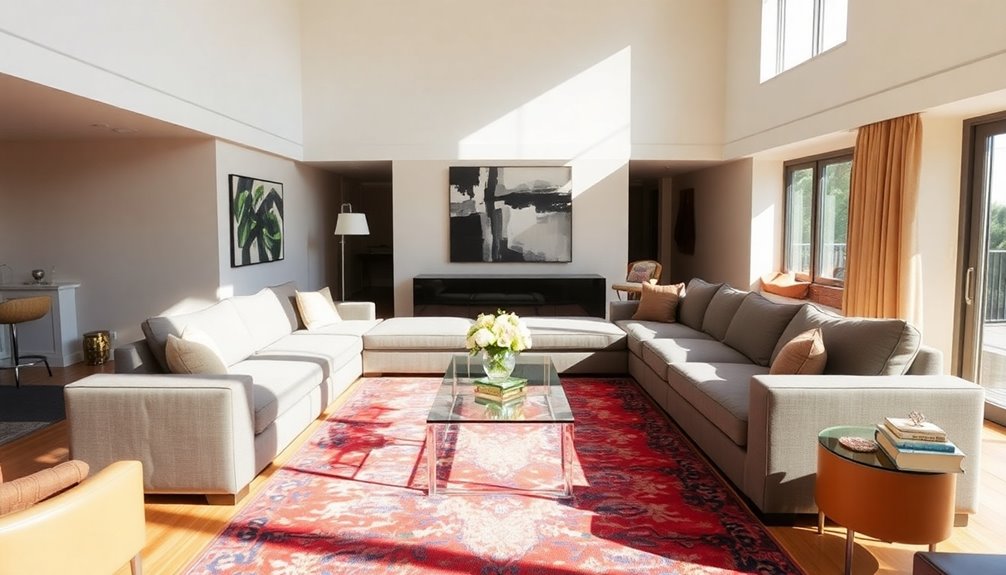
Identifying a focal point in your long living room is essential for creating a cohesive and inviting space. Start by looking for natural focal points, like architectural features such as fireplaces, bay windows, or built-in bookshelves. If you have large windows or French doors showcasing a beautiful view, these can serve as striking focal points, too.
Consider what draws your eye first when you enter the room. This could be a unique object, like a sculpture or an eye-catching piece of furniture. Remember that a single main focal point is ideal to avoid clutter and confusion. A well-defined focal point can significantly enhance the overall ambiance of the room.
Once you've identified your main focal point, enhance it with accents and artwork to draw attention. Use lighting strategically to highlight it and consider adding decorative items that complement its style. Symmetry can also help create a balanced look around the focal point.
Finally, think about any secondary focal points you may have. Place them thoughtfully so they support the main focal point without overshadowing it, ensuring a harmonious layout throughout your long living room.
Choosing the Right Furniture
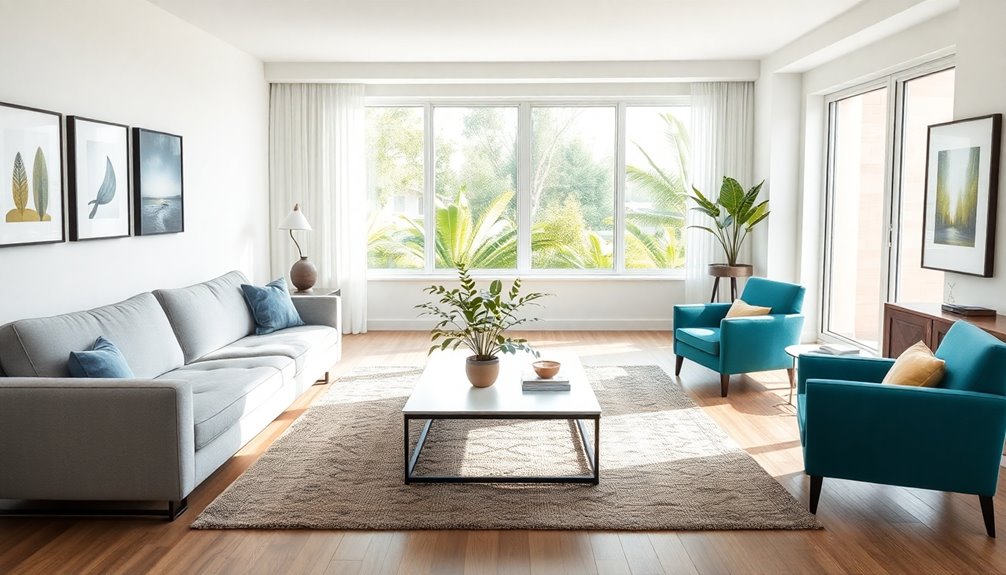
Choosing the right furniture for your long living room can transform the space into a functional and inviting area. Start by measuring your room to determine what furniture will fit without overwhelming the space. For larger living rooms, opt for bigger sofas or L-shaped sectionals to fill out the area effectively. In smaller rooms, choose smaller pieces to avoid a cramped atmosphere, ensuring there's enough room for movement. Additionally, consider maximizing IRA contributions to free up funds for quality furniture purchases.
Streamlined and versatile furniture can create a cohesive look. Consider modular options that allow for flexibility in rearranging your layout, such as a sofa with a chaise lounge. Rectangular coffee tables work better in long spaces than round or square ones. Multi-functional furniture maximizes both space and functionality.
Don't overlook corner spaces; L-shaped sofas are excellent for utilizing these often neglected areas. Position the long side against a wall to keep pathways clear. Balance large and small pieces to maintain harmony, ensuring each seat is close to a tabletop. Keep chairs within eight feet of each other for easy conversation and avoid blocking pathways with large items. With thoughtful choices, you can enhance both usability and comfort in your living room.
Enhancing Aesthetics and Functionality
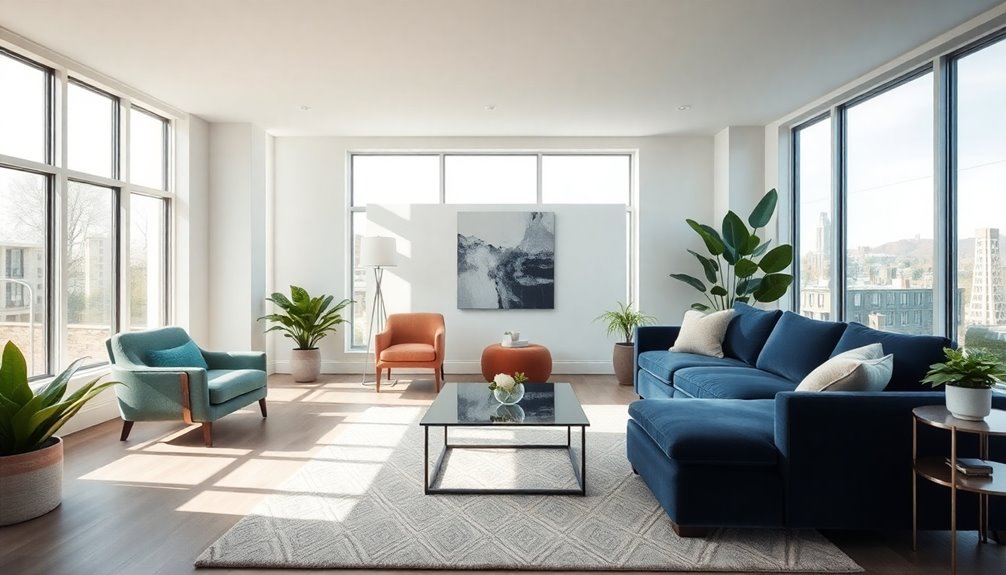
How can you enhance both the aesthetics and functionality of your long living room? Start by utilizing vertical space with tall bookcases or shelves. This draws the eye upward, making the room feel more expansive. Incorporate multifunctional furniture, like a coffee table with built-in storage, to maximize utility. Arrange your furniture to create distinct zones, such as a main entertaining area and a cozy reading nook, ensuring there's a clear path between them for easy traffic flow. Additionally, embracing the art of decluttering strategies can further contribute to a serene environment.
To achieve visual balance, use symmetry by placing identical chairs or side tables. This harmonizes the space and breaks up the elongated shape of the room. Position identical sofas on either side with a coffee table in the center to maintain that balance. A focal point, like a fireplace or TV, anchors the arrangement and adds interest. Additionally, consider how furniture placement fundamentals can guide your arrangement for enhanced comfort and flow.
Enhance the illusion of space by using vertical stripes on walls or placing a large mirror to reflect light. Float furniture away from walls to create flow, while light-colored area rugs can help define zones without making the room feel cramped. By following these tips, you'll create a living room that's both beautiful and functional.
Frequently Asked Questions
How Can I Maximize Natural Light in a Long Living Room?
To maximize natural light in your living room, start by placing mirrors opposite windows to reflect sunlight. Use light, neutral colors for walls and furnishings to enhance brightness. Incorporate large windows or replace screens with floor-to-ceiling options. Keep window treatments light-colored and clean for optimal light flow. Choose slimline furniture that won't block sunlight, and arrange it to direct light deeper into the space, creating a brighter, more inviting atmosphere.
What Types of Plants Work Well in Long Living Rooms?
In a long living room, you can enhance the space with tall plants like the Fiddle Leaf Fig or Kentia Palm, which add height and drama. For bright areas, consider Pothos or Areca Palm to fill the room with lush greenery. If you have low light, Snake Plants or Peace Lilies thrive well. Hanging options like String of Pearls can also create a cascading effect, making your living room feel more vibrant and inviting.
How Do I Choose Colors for a Long Living Room?
When you choose colors for a long living room, consider the room's lighting and orientation. If it gets a lot of sunlight, cooler shades can balance that brightness, while warmer colors create coziness in dimmer spaces. Stick to a harmonious palette that complements your furniture and decor. Neutrals work well for versatility, but don't shy away from bold colors to add interest. Sample paints at different times to see how they change with the light.
What Are Some Tips for Maintaining Clear Pathways?
To maintain clear pathways, ensure your passageways are at least 3 feet wide. Avoid blocking paths with large furniture and position pieces to keep sightlines open. Leave enough space between seating and traffic routes to prevent congestion. Use area rugs to define zones without obstructing walkways. Lastly, float furniture away from walls to promote flow and consider the height of furniture for ample clearance above your walkways.
How Can I Create a Cozy Atmosphere in a Long Room?
To create a cozy atmosphere in your long room, start by defining distinct zones for different activities, using furniture and area rugs. Layer your lighting with ambient, task, and accent sources to enhance warmth. Incorporate various textures and natural materials, like soft fabrics and wood, to add depth. Finally, choose a warm color palette with rich hues to evoke intimacy, making the space inviting and comfortable for relaxation and conversation.
Conclusion
By carefully assessing your long living room and defining zones, you'll create a functional and inviting space. Remember to identify a focal point that draws the eye and choose furniture that complements your layout. Don't forget to enhance aesthetics with decor that reflects your style while ensuring it all serves a purpose. With these tips, you'll transform your long living room into a cozy and stylish area perfect for relaxation and entertaining.
